In the 1880s. Note the rider in the center holding a dog in his lap.
DYLAN AND GODARD
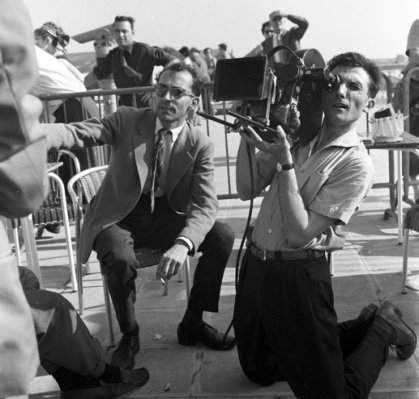
Jean-Luc Godard always had a strong identification with Bob Dylan, a sense that their careers, their artistic journeys and even their lives were somehow linked, even though they never worked together. The idea is not as strange as it sounds. Both were artists steeped in tradition, the tradition of cinema in Godard's case and the tradition of American music in Dylan's. Both were looking for ways to bring what they loved from those traditions into the present, to give them a form that would be alive for the future. Both were re-mixers, who made startling recombinations of old things that they then inflected with a purely contemporary resonance.
Both also had serious motorcycle accidents that resulted in periods of seclusion.
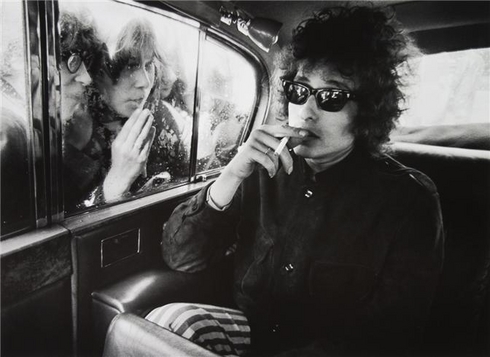
In the late 70s, each artist began to lose touch with his traditional audience — Dylan wasn't making much of a showing on the charts anymore, Godard was finding it harder and harder to get financing for his films. They weren't cutting the same figures on the cultural stage that they had in previous years.
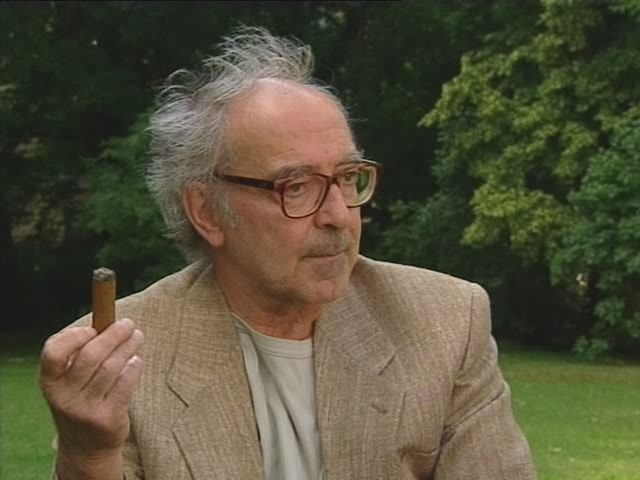
Godard took an interest in Dylan's fortunes, kept track of his successes and failures — since they seemed in some ways to mirror his own. It wasn't just a question of sympathy with a fellow artist in a similar predicament — it was a question of an almost mystical identification with one of the only artists of the 20th Century operating at his level of genius and accomplishment, and thus one of the only artists of their time who could possibly understand what it felt like to be Jean-Luc Godard in commercial and cultural isolation.
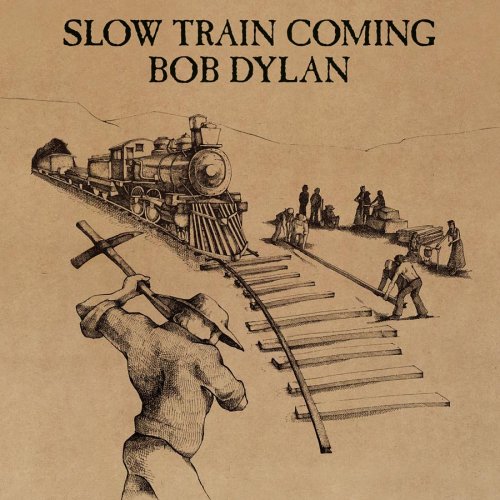
Most surprisingly, Godard has reported that when Dylan “turned to Christ” in 1978, he said to himself, “That will happen to me, too.” Then he forgot about it, until he made Hail Mary in 1984. “Look,” he said. “Dylan warned me.”
MICRO MOVIE ESSAY: CHAMPS CONTRE CHAMPS
[Photo by Jae Song]
Another micro movie essay on cinema, from the usual suspects, Kendra and the three J's — Champs
Contre Champs, French for shot-countershot, one of Jean-Luc Godard's
bêtes noires. Find out why!
Micro Movie Essay #4 — Champs Contre Champs:
YouTube
Facebook Fan Page
Prescription for the future of cinema — go back to the beginning and rethink everything.
OFFSCREEN
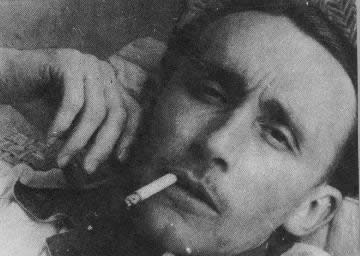
André Bazin (above) wrote some of the most penetrating analyses of how screen images work, but, as I’ve suggested before, he had a blind spot in his obsession with a movie’s connection to visual fact, its function in providing “evidence”. He was saying something important about the psychological effect of the camera’s intimate relationship to physical reality, but his theories can’t explain why the imaginary spaces created in animation, for example, can have the same emotional and psychological power, the same cinematic power, as spaces recorded photographically.
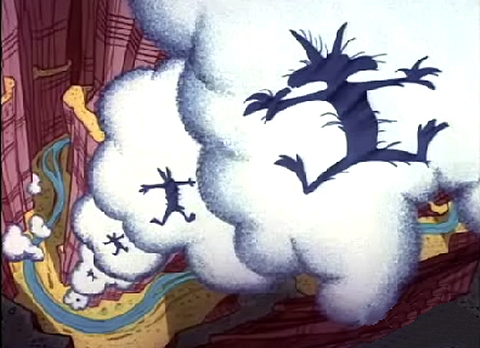
This blind spot also led Bazin to draw a misleading contrast between stage space and screen space. With stage space, he argued, we’re always half aware of the backstage machinery that creates theatrical illusion, while a screen image gives the illusion that it’s only a window onto a wider, complete world.
This is not always true, even — perhaps especially — in the work of one of Bazin’s heroes, Orson Welles. I recently ran across a passage from the critic Chris Fujiwara which sums the issue up nicely:
In radio, all space is “off” and is evoked by sound, which alone has
materiality. From his experience in radio, Welles sometimes brings to
film a purely vocal offscreen space, as in the scene of the dying Major
Amberson contemplating something that “must be in the sun.” But
offscreen space as conjured by the looks and movements of characters to
impose an imaginary spatial coherence – this is something Welles has
little interest in. He prefers to leave offscreen space unfilled, to
reorganize the world with each cut, or to deny the offscreen by
enfolding all space, all revelation within a single shot. Welles’s
cinema is a forgetting of offscreen space, a denial of its potency.
This strikes me as quite true. The amazing long take in The Magnificent Ambersons of George eating strawberry shortcake in the kitchen as he talks to Fanny and then to Uncle Jack behind him in a deep onscreen space, seems to me to represent a precise and wholly self-contained theatrical environment. Even though the shot records a convincingly “real” place, I still feel that Uncle Jack enters the scene in the far background from “the wings”.
Welles has thoroughly theatricalized that space — we have no appreciable sense at all of a wider, complete world beyond it.
[The Fujiwara quote comes from a special issue of La Furia Umana, an online cinema magazine, devoted to Welles — which I found via Wellesnet. The issue contains articles on Welles in English and in other languages.]
MICRO MOVIE ESSAY: TRACKING
Kendra, James, Joe and Jae return in a new essay on cinema — Tracking!
— which critics are already calling the greatest micro movie ever
made. Personally, I don't see how it can ever be surpassed. Craig
Schober records sound and helps move the platform! David Ure assists!
The screen explodes with excitement!
Micro Movie Essay #3 — Tracking:
YouTube
Facebook Fan Page
Prescription for the future of cinema — go back to the beginning and rethink everything.
WHILE YOU WERE SLEEPING
. . . the Jesus of the Gospels was transformed into some sort of cavalry or Boy Scout troop leader, complete with guidon. He's ready for business, church business, getting the organization in line.
This fresco by Piero della Francesca is a great work of art — Aldous Huxley once called it “the best picture in the world” — but I defy anyone to be moved by it, except on an aesthetic level. Easter is happening somewhere else . . . or so I've heard tell.
MARY MAGDALENE WEEPING
This is Arnold Böcklin's Mary Magdalene Weeping Over the Dead Christ. Almost everything about it strikes me as wrong — psychologically, dramatically, narratively, even theologically. The translucent black mantle lends the image a perverse erotic quality. The Magdalene's grief seems melodramatic, almost self-involved — the beautiful figure of the dead Christ becomes a prop for a diva.
And yet . . . it delivers a grisly, Gothic frisson, of the sort Böcklin specialized in, unsettling, macabre. It's hard to stop looking at it.
GOOD FRIDAY
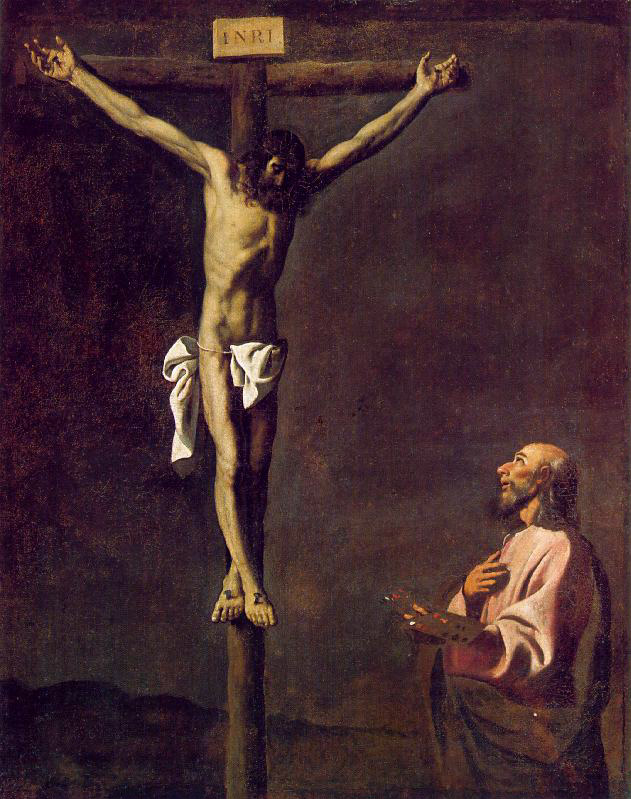
For Francisco de Zurbaran, Spanish artist of the 17th Century, painting Jesus on the cross was in some sense the same as standing before Jesus on the cross. The figure with the palette is said to be Saint Luke depicted as a painter, but surely Zurbaran was painting himself into the crucifixion scene — seeing his witness with oil paints as the virtual equivalent of eyewitness testimony.
I don't know if they do that kind of thing anymore.
CATHOLIC CHURCH CONTEMPLATES NAME CHANGE
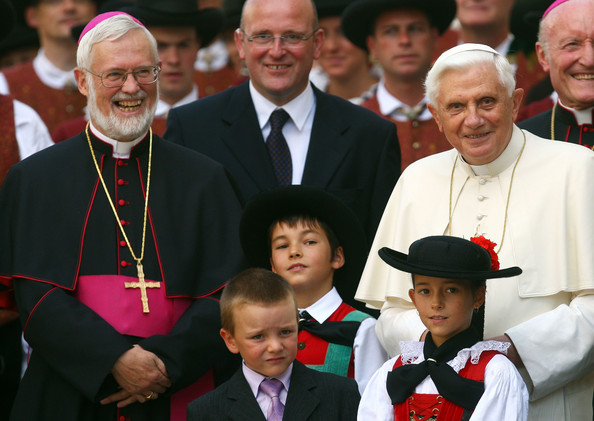
Like Blackwater and other large corporations beset by image problems, the Catholic Church is quietly exploring the possibility of a name change. Pope Benedict XVI has appointed an advisory committee composed of respected cardinals and prominent lay persons to study the issue.
Vatican spokeman Father Federico Lombardi admitted the existence of the committee yesterday, but said the Pope was far from a decision on the subject. “It's just something that needs to be considered,” Fr. Lombardi said. “I mean, let's face it, when most people hear the name 'Catholic Church' today, what they think is, 'Holy Roman Fuck Buddies', and that cannot be good for the church's mission on earth, which is to provide satisfying but innocent companionship for adult males in holy orders who want to spend quality time with young, attractive boys.”
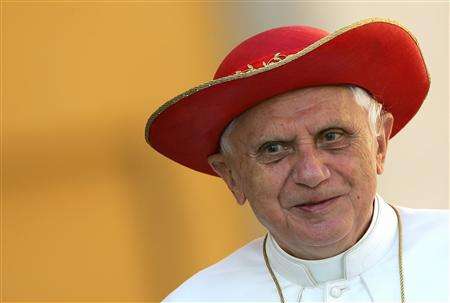
Names under consideration by the committee include “The Pastoral Party-Time League” and “The Jesus Playhouse Group”, though insiders say that the Pope himself is leaning towards “Big Peter's Boys Club International”, because, as the Pope is reported to have said, “It makes me feel all wiggly inside.”
COMANCHE STATION
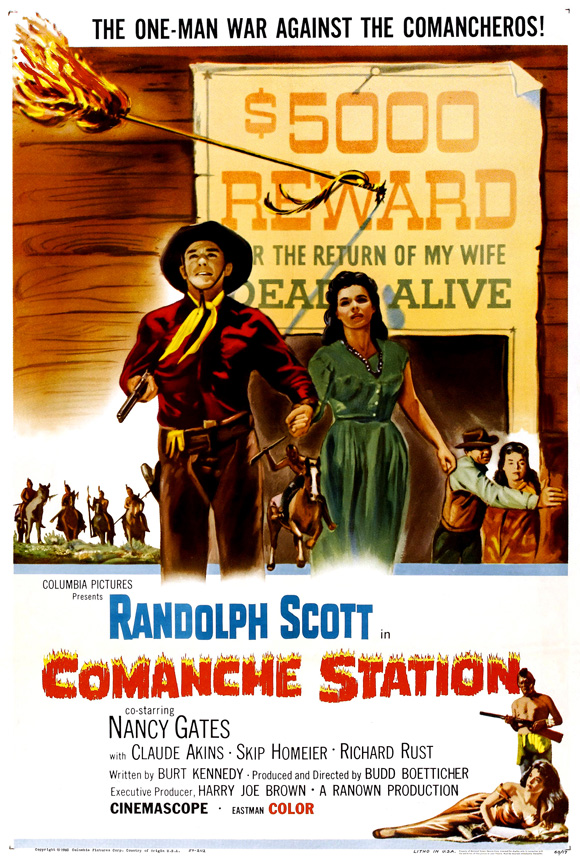
Budd Boetticher's Comanche Station might just be the greatest film ever shot in twelve days. It's lean and mean, with a small cast, absolutely no interiors and only two exterior sets that needed dressing. Its script is short, with terse dialogue that suggests much without going into detail about anything.
As a model for how to shoot landscapes, with people and horses moving through them, the film cannot be bettered, even in John Ford's Western oeuvre. Some of the long tracking shots of people riding and talking are like self-contained lyric poems. The action sequences are choreographed with unerring skill, a sure sense of the drama inherent in complex movements through space — beautiful without ever becoming glamorous.
Horses are not props in this film, as they are in almost all modern Westerns — they are true characters in the story, shot with admiration and respect for their magnificence and grace and power. Boetticher knows that a horse and rider crossing a deep river is among the most beautiful things it's possible to witness on this earth.
One could almost call this a chamber Western, except that there are no chambers in it — only rugged country and big skies and people trying to stand out against them. In Boetticher's universe, they do this by acts of moral, not physical, heroism, although the latter tend to flow inevitably from the former. It's a small work by Hollywood standards, but it's bigger than Avatar in its mastery of storytelling and cinematic form — it gets its 3D effects the old-fashioned photo-chemical way. It dazzles, blows you away, by its simple, elegant perfection.
RIO GRANDE
Rio Grande, from 1950, the last film in John Ford’s cavalry trilogy, isn’t really about the cavalry, it’s about marriage, and like any serious work about marriage it deals with the subject of boundaries — boundaries respected, boundaries transgressed and boundaries transcended.
“Love is the mutual respect of two solitudes,” says Rilke, but in a marriage those two solitudes interpenetrate, in the partnership of daily living, in sexual intercourse and in the not unrelated phenomenon of bringing children into the world. To say that it gets complicated is to put it very mildly indeed.
The river that gives this film its title is itself a boundary, of course, between two countries. Its very name embodies its divisive nature — on the Mexican side, the river is called the Rio Bravo, reminding us that people don’t always have the same names for the things that separate them, complicating communication considerably. The river is problematic for the film’s protagonist, Colonel Kirby Yorke, played by John Wayne, because Apaches living on the Mexican side are raiding into U. S. territory and he can’t follow them back to their refuge below the border.
He is compelled to respect the boundary and also to find a way out of the dilemma this places him in. He offers to put his command under the authority of the Mexican army for the purposes of a punitive expedition against the Apaches, who are bedeviling Mexicans as well, but national pride prevents the Mexican army from accepting help.
This is a fine set-up for a Western adventure film, but it’s only a metaphor for the film’s real drama, which concerns Colonel Yorke’s marriage.
Yorke has been estranged from his wife for seventeen years, ever since, under orders, he burned down her family’s Virginia plantation during the Civil War, after which she came to hate soldiers, the profession of soldiering, and him. She took their infant son with her when she left him, but the son has become a soldier himself now, seventeen years later, against her will, and has been assigned to serve under his father at the remote fort near the Rio Grande.
Kathleen Yorke, played by Maureen O’Hara, shows up at the fort to purchase her son’s release from the army — but neither the son nor the father is prepared to sign the necessary papers, as they stare each other down across another kind of chasm, the awful chasm that exists between a father and son who don’t know each other.
Here, then, is one spectacularly dysfunctional family. Proximity saves them — proximity and the ritual etiquette of military life, of gallantry between the sexes. With personal passions roiling beneath the surface, they treat each other with respect, obeying the outward forms of civility, long enough to get to the bottom of things, to transcend their personal passions — bitterness, suspicion, resentment, shame, wounded pride.
The outward forms of civility, military and courtly, are all about respecting boundaries — establishing a border between people across which they have a chance of seeing each other as individuals.
But these borders exist to be crossed — and this is the ultimate profound and paradoxical message of Ford’s film. Yorke’s commanding general finally orders him to cross the Rio Grande in pursuit of the Apaches, in violation of international law. Yorke finally hauls off and kisses his wife, transgressing the line she has drawn between them. His wife offers to clean and repair his uniform — his soldier’s uniform, the symbol of everything she despises about him. The son crosses his own boundary into self-sufficient manhood, and the parents allow him to do it — and their re-established love for each other gives them the courage to do it.
People who see this film as simplistic, as an old-fashioned celebration of gallantry towards women, of military life, completely miss the point. The darkness in Yorke’s soul, the existential loneliness of his wife and son, are as devastating as any portraits of despair in a film noir. The rituals that save them are also the rituals that imprison them. There is no simple way to cross the Rio Grande — the cost of the crossing is enormous, almost more than the characters can bear. But the only salvation lies on the other side of the river.
Rio Grande is a film often damned with faint praise, but it’s one of the greatest of all American films, and in its deceptively simple, elegiac way, one of the deepest and wisest films ever made about marriage.
It’s a film whose sublime artistry is disguised by hiding in plain sight. Take for example the remarkable sequence in which Ben Johnson and Harry Carey, Jr. put on a display of Roman riding — galloping around a ring and taking a jump while standing on the backs of two horses running together. It’s a display enacted mostly for the Yorkes’ son Jeff, who must then try it himself, with mixed results.
Jeff has to learn a similar skill in life — finding a footing in the world of his mother and the world of his father, before he can come into his own as a man. And they must relearn how to work as a team in order to give him a chance to find that footing. The whole interior psychology of the film is thus summed up in a series of stunning visual images that on the surface read as a throwaway action interlude.
Cinema just doesn’t get any better or more eloquent than this.
[With special thanks to Dr. Macro’s High Quality Movie Scans for the illustrations.]
SUB SPECIE AETERNITATIS
For my sixtieth birthday my friend Lang Clay sent me a print of the portrait above which he took of me in my loft on 21st Street in New York City around 1973.
He took it with an 8 x 10 view camera, with existing light using a long exposure. He was trying to recapture the aura of 19th-Century photographic portraits, in which the subjects always look uncannily composed and serene, as if posing for the gaze of eternity. This was in large measure due to the long exposure times required back then — one has to compose oneself to stay still for such a length of time.
The print Lang sent me was enormous — roughly 18 x 23 inches. A print that size really reveals the astonishing amount of “information” contained in a properly exposed 8 x 10 negative, which produces an almost 3D effect. The presence of my long-vanished self is intense in the image, and thus doubly melancholy and spiritual — I seem to be looking into my future with perfect calm, as the subjects of 19th-Century photographic portraits look into our time, a time in which they no longer exist.
In the portrait, I too have entered history — my twenty-three year-old self seems as far off as the Battle Of Antietam, as indeed in some sense it is. And yet it only tells part of the truth, because I feel, and in some real ways am, younger now than I was when the portrait was taken. (Below, another image from the same session.)
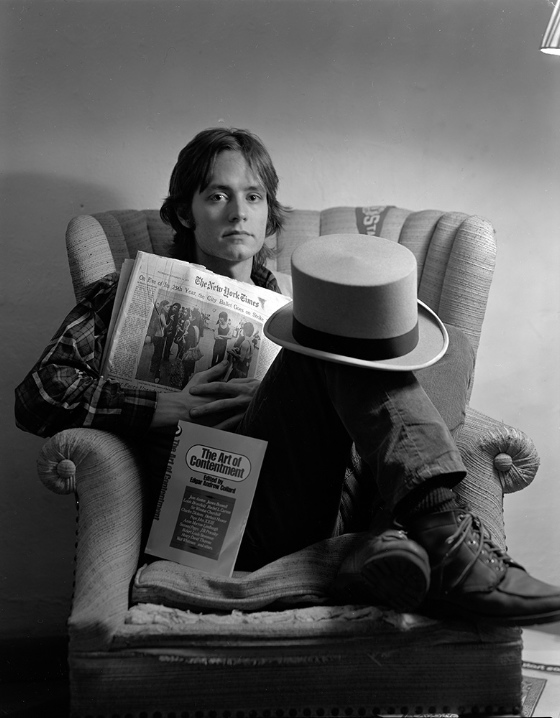
Time has roughed me up, but it has also opened me up — and that’s another sort of mystery photographs can illuminate, as they age along with us through the years.
I keep thinking of what my current self could tell that young man in the pictures — don’t be so afraid, don’t be so closed off, don’t be so cynical . . . time is your best friend. But I know him — he wouldn’t have listened to a word of it.
FLOATING AWAY
[Photo © Hugh McCarten]
A year ago today Oscar Fruchtman died, way before his time. Oscar was an extraordinary presence in the lives of everyone who knew him — brilliant, hilariously funny, haunted by demons. He was a gifted musician and songwriter, who could write funny and also write sweet.
My friend Hugh McCarten was one of the people who knew him best, and Hugh was asked to deliver the eulogy at Oscar's memorial service, which is linked to below. But before you read it, listen to a song Oscar wrote (with Hugh contributing some to the lyrics), “Floating Away”, which is both funny and sweet — a song about Noah, about hope and rebirth and faith:
Floating Away (© 2010 A. Fruchtman/H. McCarten)
This is a live recording from The Rose Tattoo in Key West, Florida, from March of 1979 — with Oscar and Ed “Woody” Allen on guitars, Din Allen on bass, Hugh on toy organ, Oscar singing lead and the other lads doing back-up vocals.
Here's what Hugh had to say about Oscar when it came time to bid him farewell:
Eulogy For A Luftmensch
(In the eulogy, Hugh quotes the lyrics from another song by Oscar, “Brooklyn Boy” — you can listen to Oscar perform it here.)
CELEBRATING OSCAR
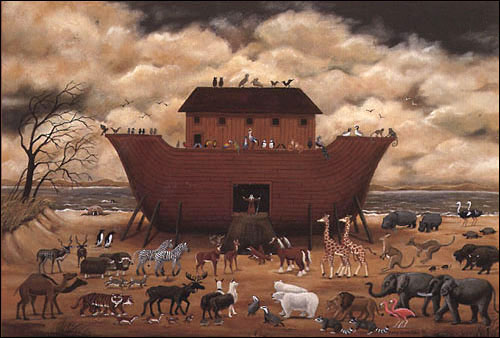
EULOGY FOR OSCAR
Oscar Fruchtman died on the morning of Saturday, March 28, 2009 in his
apartment at the Kenmore Residence on East 23rd Street in Manhattan.
This eulogy was given on Monday, March 30, 2009 at the Plaza Jewish
Community Chapel, 630 Amsterdam Ave. Previous speakers at the service
were Rabbi Emeritus David H. Lincoln and Rabbi Elliot Cosgrove, both of
the Park Avenue Synagogue.
My name is Hugh McCarten and I was Oscar’s longest serving friend. I
was his best friend. Rabbi Lincoln said we should always be prepared
for circumstances like this, but I wasn’t prepared when Oscar passed
away on Friday [from the audience, Janet Moss, Oscar’s mother:
“Saturday!”] Oh, right – Saturday. And I’m not prepared for what I’m
doing now, but as Oscar’s dad Carl used to say, “These are the knishes
that prevail.” So we’re going to go ahead. The topic is remembering
Oscar and I’m trying to think of the best way to do that. Rabbi
Cosgrove suggested that perhaps Oscar, following Talmudic tradition,
was one of the “Lamed Vovniks”, 36 righteous individuals who are on the
earth at any given time and without whose divine presence the world
could not endure. That’s possible, but I came across a word recently
that I am sure applies to Oscar and the word is “luftmensch”, literally
an “air man”, a dreamer.
And apparently Oscar was a dreamer from the beginning. I first got to
know him and his wonderful family back in the early 1970s and he told
me that practically his first memory was of his parents' liquor store,
South Ferry Liquors. As a young child, he said he couldn’t quite
understand what “South Ferry Liquors” meant and thus he envisioned some
kind of fantastic combination boat/store that went careening around the
New York harbor. And so began his dreaming . . .
He told me he had been named after his grandfather, whose spirit it was
suggested he had inherited, and he told me about his grandmother Sadie,
who liked to invoke the 11th Commandment: “Don’t Get Caught!” And about
his Uncle Louie who died in 1957 at Yankee Stadium in the middle of a
New York Giants football game and about growing up in Brooklyn on
Ovington Avenue and later on Eastern Parkway. He told me about going to
Stuyvesant High School and becoming the International President of USY
– United Synagogue Youth. Oscar was, as some of you know, a great
songwriter and I wish I could sing a bunch of his songs today, but we
don’t have time, so I’d like to read the lyrics of a song written in
the 1970s that sums up his youth and its title is “Brooklyn Boy”:
BROOKLYN BOY
I don’t say much but I’m a fast talker
I never look I’m a jay-walker
I guess you could say I’m a New Yawker
I’m just a Brooklyn Boy
From Flatbush to Brooklyn Heights
You better not miss those Brooklyn sights
Botanical Gardens and Prospect Park
But you better lock your door when it gets dark
I used to root for the Brooklyn Dodgers
Duke Snider, Pee Wee Reese, the late Gil Hodges
I used to love to watch Roy Rogers
I’m just a Brooklyn Boy
Coney Island, down by the sea
I just hop right on that BMT
Mom cooled Pepsi right in the fridge
And Daddy tried to sell the Brooklyn Bridge!
I used to eat in a delicatessen
Turkey on club with Russian dressing
Then I would take my piano lesson
I’m just a Brooklyn Boy
I’m just a B-r-o-o-k-l-y-n
I’ll probably sing it once again
I’m just a B-r-o-o-k-l-y-n
Brooklyn Boy
(Music and lyrics by O. Fruchtman)
(©2010 A. Fruchtman)
[Here's a link to Oscar performing the song live — “Brooklyn Boy” .]
Then the Brooklyn Boy went to Princeton and after appearing in some
Triangle Club shows there, he started making his way in the showbiz
world.
He began playing the guitar and singing with Princeton classmate and friend Ed
(Woody) Allen and later I joined the two of them and we formed a band –
Oscar and The League Of Weenies. In 1974 we became the first band ever
hired to play at the club CBGB and two weeks later we were the first band
ever fired from playing at CBGB. All through the early and mid-70s
Oscar was hanging around some of the most creative people on the New
York scene, especially the folks involved in the early years of the TV
show Saturday Night Live. At one point Michael O’Donoghue, the head
writer for the show said,” You know, all Oscar needs is a little
success.” But Oscar never found any real commercial success and at
crucial moments he seemed to have a special knack for sabotaging his
opportunities and, frankly, manipulating and ultimately alienating
people. I asked him once about this tendency and he said, ”Well, you
know my motto – I’ll burn that bridge when I get to it.” And so – he
did!
And he turned away from the traditional path and became his own
creative universe. He was a poet, a singer and songwriter, a street
performer, a painter, a collagist . . . A message from Oscar on your
answering machine might be a miniature masterpiece. I’m now holding up
a business card he had made up for a fictional concern located on
Medford Avenue in Fairlawn, N.J. And the outfit is called: “Mind Your
Own Business!“ and their slogan is “Don’t Call Us and We Won’t Call
You!”.
You didn’t hear Oscar on the radio or see him on TV, but the whole
world was his canvas. And he travelled with a mission. He was seeking
the essential humorous truth of life. And this was his exacting
discipline: He was the master of taking any situation, finding the
precise comic center and putting it into words – words that made you
laugh. In my opinion he was quite simply the funniest person ever. Nor
did it matter if he was the butt of the joke – what was paramount was
the comic truth. And he filled his memorable songs with humor and they
overflow with warmth and humanity.
So this was a brief attempt to take the measure of my friend Oscar
Fruchtman. He was a luftmensch who had enough adventures and burnt
enough bridges for several lifetimes. He loved his family, he loved his
friends, he loved his music and, above all, he loved to create
laughter, that rarest ability and his special gift to all. Oscar, you
did a lot of surprising things in your life, but what you did on
Saturday surprised me the most. And Janet and Annie and Peter and I
will never forget you, because you are unforgettable. And we are so
proud we had the chance to share your time on earth.
Rabbi Cosgrove said he was going to pull on his earlobe if I was
talking too long and he hasn’t done that yet, so I’m going to get out
my guitar and sing a song Oscar and I wrote – it’s mostly Oscar, but I
contributed a little.
(While getting set up, I took a swig from a bottle of Poland Spring
[from the audience, Janet Moss, Oscar’s mom, “Drinking on the job!”])
This song is very appropriate for this setting and you’ll hear why.
It’s called “Floating Away” . . .
FLOATING AWAY
‘Twas the night that Noah went crazy
And he started to talk about building a boat
'Twas the night that Noah went crazy
And he started to talk about floating away
Floating Away – I don’t care what the people say
For I’ll be floating away, waiting for the break of day
Everybody laughed when he talked about building his craft and floating
He talked about taking two of each kind
He talked about leaving it all behind
And he grabbed his hat and he grabbed his coat
And he mumbled something about floating away
Floating Away – I don’t care what the people say
For I’ll be floating away, waiting for the break of day
Hey, what’s with Noah? If he don’t move that ark they’re going to tow
it away
But he just ripped up the ticket and he stowed it away
Cause he’s soon to be floating away
Floating Away – I don’t care what the people say
For I’ll be floating away, waiting for the break of day
First there came the wind – I hope he’ll let us in
Then there came the rain, maybe Noah’s not insane!
‘Twas the night that Noah went crazy
And he started to talk about building a boat
'Twas the night that Noah went crazy
And he started to talk about floating away
For forty days it rained then the sky was clear and the land was dry
And the bird of peace flew by and Noah got high
And again he was floating away
Floating Away – I don’t care what the people say
For I’ll be floating away, waiting for the break of day
(Music by Oscar Fruchtman/Lyrics by Oscar Fruchtman and Hugh McCarten)
(©2010 A. Fruchtman/H. McCarten)
